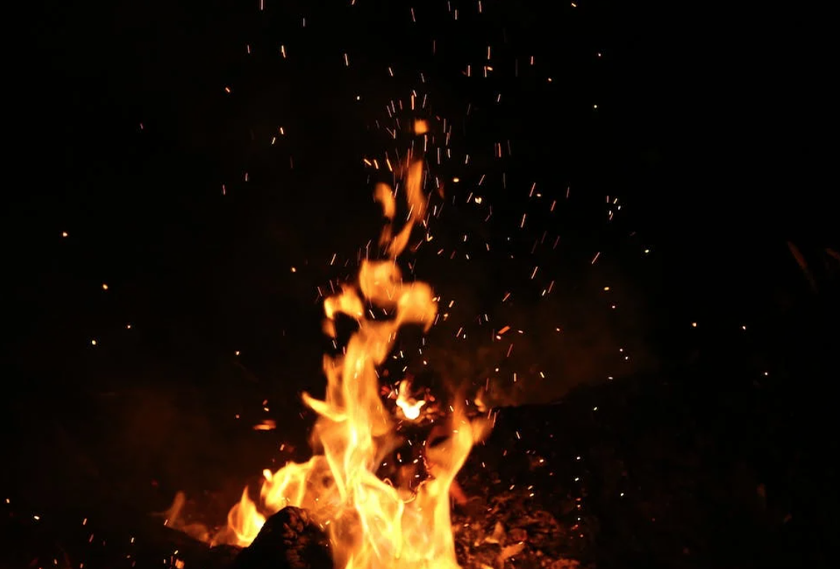Playing With Fire - Safer Ways to Tune up your Cannabis Ignition System

Playing with Fire
Safer Ways to Tune Up Your Cannabis Ignition System
by Mark Mathew Braunstein
What You Smell Is What You Breathe
Countless medical studies have shed light upon the health risks of smoking herbs, be they tobacco or cannabis. Yet most smokers hide behind a smokescreen of denial in recognizing the risky business of inhaling the ignition fumes from lighters or matches. Their foul odors alone alert us that they are unsafe to breathe. Because if you’re smelling them, then you’re breathing them.
Typically, you light up a tobacco cigarette just once. Chemical additives to control the burn rate account for that one-match wonder.1 Thankfully, cannabis lacks such additives. So joints sometime require firing up a second time, and pipefuls several times. As the cumulative ignition fumes for every joint or pipeful of cannabis pose more risks than per tobacco cigarette, it is high time to explore safer ways to tune up your ignition system.
The Unmatched Hazards of Matches
Most matches are “safety matches,” the word “safety” distinguishing them from less common “strike-anywhere matches.”
Strike-Anywhere Matches contain potassium, phosphorus, sulfur, and perchlorates combined into one matchhead. Perchlorates are also used in explosives, flares, and fireworks. Stand anywhere within their striking distance and you will be painfully aware of the foul smell of the plume of strike-anywhere matches. Simply sitting in the box, they smell toxic.
Safety Matches are those you stick on the matchbook or matchbox. The sulfur and highly flammable phosphorus are removed from the matchhead. Instead, they are placed into the striking strip alongside the matchbox or matchbook. Thus the phosphorous and sulfur do not fill the air with their toxic fumes. Safety matches indeed are safer. For your lungs.
Matchsticks of both types of matches present another peril. Hold them for too long and, Ouch! You’ll burn your fingers. Numerous studies have proven that burns are not conducive to good health.
Because hot air rises, when striking a match hold it at arm’s length or over your head. You might look funny, but because you’re not inhaling the matchhead’s fumes you’ll breathe easier.
Making Sparks with Spark Lighters
Flicking a lighter fills the air with less noxious fumes than when striking a match, so lighters might prove safer than matches. Cheap disposable lighters designed to fit inside a pack of cigarettes are sparked by ferrocerium flint, while non-disposable models are sparked by piezo quartz.
Flint Lighters require you to flick the flywheel with your thumb. After many flicks, the tip of your thumb will form callouses or abrasions. When you flick the flywheel, it creates a spark by scraping against ferrocerium, a hazardous metal. When flicking, you stir up a toxic cloud of microscopic ferrocerium dust. Allow the ferrocerium dust to settle before you hold the flame to your joint. Forget about pipes. Like from a candle, the flame from a flint lighter rises only upward. For a pipe, when you hold the lighter sideways, that flame easily extinguishes while you are still inhaling, presenting the risk of inhaling incompletely combusted butane fumes.
Piezo Lighters are sparked by quartz crystals that create an electrical charge. They eliminate the toxicity of faux-flint. Their flames that can be aimed sideways and even upside-down. Also known as torch lighters or cigar lighters, they are ideal for firing up pipes. In fact, piezo lighters are also called pipe lighters. Ignited by a pushbutton rather than a sparkwheel, piezo lighters are kind on both your thumb and your lungs.
Both flint lighters and piezo lighters are usually fueled by butane. Beware butane.
Butane-Fueled Lighters
As the most common fuel for cigarette lighters, when butane is stored under pressure inside the lighter it is liquid. Once released from the lighter, the liquid turns into a colorless gas with a very faint but unpleasant odor. If you’ve always ignored the frightening fine print on the warning label on a lighter, you’re overdue to read one now.
Butane fumes are both toxic and intoxicating. Some foolish little kiddies, desperate to get high, intentionally sniff the non-combusted fumes from butane cannisters. Doing so can prove fatal.2 Small-dose short-term effects include headache, dizziness, and coughing. Long-term effects from repeated use include kidney, liver, heart, and brain damage.3 The direst effects are from non-combusted fumes straight from the liquid butane cannister. You do not use butane directly from a cannister, but rather combusted from a lighter in order to fire up your herb. So never press on the lever of the lighter without sparking it. Yet even when you do light the butane, your first toke will cause you more harm than any smoke from any herb, be it tobacco or cannabis. Because on that first toke, way too many tokers also inhale the butane fumes.
As a sober-minded adult, keep your lighter out of reach of children. And as an adult, go light on your use of lighters.
Flameless Lighters
Flameless lighters, first called Tesla lighters, have been dubbed with a variety of descriptive names such as electronic lighters, electric-arc lighters, electronic-coil lighters, and plasma-beam lighters. Nowadays almost all get juiced on USB charges, so add USB lighter to its list of aliases. While the buzzword “plasma” sounds like something living and “electric-arc” adds the allure of hi-tech, calling it “flameless” better distinguish it from the more common flame-emitting butane lighter.
Flameless lighters are windproof, waterproof, and leakproof. Their buttons, unlike those on flint lighters, are easy on your thumb. Free of chemicals and odors, they eliminate the toxicity of both flint and butane. Press its button, and the coil emits an arc-shaped spark that dances between two electrodes. Place your joint into the arc and your joint ignites. Because the housing or the cap can get in the way, the arc of many flameless lighters cannot reach the contents of a pipe. That’s a job for flameless torch lighters.
Rather than single-coiled, flameless torch lighters are double- or triple-coiled. The bowls of pot pipes are smaller and shallower than those of tobacco pipes, so smaller torch lighters that make no claim about being suitable for tobacco pipes often work fine for pot pipes. Larger torch lighters, also called “pipe lighters,” are good for tobacco and cannabis alike.
Never apply a torch lighter to a pipe’s metal bowl unless its shaft is wood and you are holding the pipe by its shaft. Otherwise, it will shock you with a mild electrical impulse. Still, you might get some jollies from such shocking experiences, like schoolchildren do during science experiments in static electricity.
Compared to butane, a fossil fuel, the ignition of rechargeable flameless lighters is eco-friendly. Emitting barely any detectable odor, they are safe to inhale. No flame, no fumes, no smoke. Unfortunately, absent from this list is “no problem.” The technology is still in its infancy. Even high-priced models remain functional for only a few months. Over time, charges do not last as long, and recharging takes longer. Their nonreplaceable lithium-ion batteries eventually will die, leaving you with a nonrecyclable piece of junk.
Choose Your Weapon
Match or lighter? Striking a match fills the air with more noxious fumes than does flicking any lighter, so you would think that lighters always win over matches. Not so fast! A match can be an appropriate tool when you’re lighting up a pipe rather than a joint. So the first question to ask is, joint or pipe?
Health Tip for How to Light Up Joints: With your two hands occupied striking a match, you must hold a joint in your mouth, where you can’t avoid inhaling ignition fumes. In contrast, with your one hand flicking a lighter and the other holding the joint, you can hold both at arm’s length, so far enough away to minimize your exposure to the ignition fumes of a lighter. To more safely light up a joint, look to lighters.
Health Tip for How to Light Up Pipes: Unless the pipe stem is more than a foot (30 cm) long, when lighting the bowl you’re holding that flame right in front of your nose. Smoked leisurely, especially during solo sessions, cannabis snuffs out easily, requiring several firings per bowl. That’s toxic buildup. Nix to matches and cheap lighters that force you to suck in that flame. When smoking a pipe, the safer ignition system is the piezo lighter that can aim its flame sideways or downward, and the safest of all is the flameless pipe lighter.
The Fire Power of Candles
But wait! You can still safely put to use a match or a cheap flint lighter. Strike just one match or hit one flick, not to light your pipe, but to light a candle.
Candles are made from a variety of ingredients, including paraffin, beeswax, tallow from animal fats, and vegetable oils often from palm, soy, or coconut. Hold a white sheet of paper or board high above a burning candle, and you will capture a coating of soot, which is mostly carbon ash. Soot is only what you happen to see. Hidden to the naked eye, the candle’s fumes also contain, for instance, carbon monoxide,4 VOCs,5 and polycyclic aromatic hydrocarbons,6 called PAH for short. All are toxic.
As a petroleum distillate, paraffin is plentiful, cheap, and potentially the most harmful, as its fumes contain phthalates, a class of chemical plasticizers found to be harmful to human health.7 Health food, new age, and occult stores sell vegetable oil candles that are labeled as free of phthalates. Soy candle manufacturers make unsubstantiated claims that their candles not only emit no phthalates, but also the least amount of soot.
Despite the ubiquitous use of candles since the dawn of human history, only a few studies have evaluated the emissions from burning candles.8 We do know that added scents of any kind add to the candles’ pollutants.9 And we know that compared to the pollutants from the fumes of commonplace paraffin, beeswax is far less polluting.10
Compared to repeatedly flicking butane lighters or striking matches, lighting a candle only once has something to commend. You can place your burning candle at arm’s length, so you are out of range from its fumes. In the candle’s flame, you can stoke up a glass wand, a hemp wick, or a toothpick. Then to toke your pipeful, apply that glowing wand, that smoldering wick, or that burning toothpick. No toxic plume in your face, so none in your lungs.
Glass Wands are also called weed wands. You heat the tip of a thin borosilicate glass rod and then insert it into your herb. But danger lurks after using that scorching wand. Good luck on placing the cylindrical wand somewhere safe so it won’t roll away, ignite a conflagration, and burn down your house.
Hemp Wicks are spools of hemp twine coated with beeswax that burn slowly just like the wick of a candle. Igniting cannabis with hemp is a romantic notion that has inspired many a smoker to give it a try. But in between tokes, you must keep a watchful eye on the flimsy and cumbersome burning hemp wick, else it can ignite the entire spool. For hemp enthusiasts only.
Wooden toothpicks are safer than glass wands and hemp wicks. Flat toothpicks easily ignite from candles, and then stay lit long enough to fire up your pipe. They also are handy for stirring the contents of your bowl.
Health Tip for How to Light Up Pipes: Using an unscented candle made of beeswax or vegetable oil, light it, and then place it at arm’s length, so you are out of range of its fumes. Light a flat toothpick in the flame of the candle. With the lit toothpick, light up the bowl of bud. Wood, a natural fiber, to the rescue.
Light My Fire!
In 2014, The Wall Street Journal produced a three-minute instructional video of this author demonstrating his time-honored toothpick technique for firing up his pipe. You can view his live demo on YouTube at < https://youtu.be/2Zp1DoxodW0 > Or search YouTube by its title, “Finding Relief in Medical Marijuana, Legally.”
Happy toking, my cannabis friends!
++++
Mark Mathew Braunstein is a contributor to many holistic health magazines and the author of six books, including Mindful Marijuana Smoking: Health Tips for Cannabis Smokers, from which this article was excerpted. You can read his many editorials and articles about medical marijuana and recreational cannabis at www.MarkBraunstein.Org
Notes
- CDC (U.S. Centers for Disease Control and Prevention), How Tobacco Smoke Causes Disease: The Biology and Behavioral Basis for Smoking-Attributable Disease, Chapter 3, “Chemistry and Toxicology of Cigarette Smoke and Biomarkers of Exposure and Harm” (Atlanta, GA: Centers for Disease Control and Prevention, 2010), 44, https://www.ncbi.nlm.nih.gov/books/NBK53014/
- National Academy of Sciences, Engineering, and Medicine, Acute Exposure Guideline Levels for Selected Airborne Chemicals: Volume 12, Chapter 1, “Butane” (Washington, DC: National Academies Press, 2012), 17, https://doi.org/10.17226/13377
- National Academy, Acute Exposure Guideline Levels, 19.
- Marco Derudi, Simone Gelosa, Andrea Sliepcevich, Andrea Cattaneo, Domenico Cavallo, Renato Rota, and Giuseppe Nano, “Emission of Air Pollutants from Burning Candles with Different Composition in Indoor Environments,” Environmental Science and Pollution Research 21, no. 6 (March 2014): 4320, https://doi.org/10.1007/s11356-013-2394-2 with full text at: https://pubag.nal.usda.gov/catalog/624766
- Santino Orecchio, “Polycyclic Aromatic Hydrocarbons (PAHs) in Indoor Emission from Decorative Candles,” Atmospheric Environment 45, no. 10 (March 2011): 1888, https://doi.org/10.1016/j.atmosenv.2010.12.024
- Orecchio, “Polycyclic Aromatic Hydrocarbons,” 1895.
- Amy Westervelt, “Chemical Enemy Number One: How Bad Are Phthalates Really?,” The Guardian, February 10, 2015. http://www.theguardian.com/lifeandstyle/2015/feb/10/phthalates-plastics-chemicals-research-analysis
- Derudi, “Emission of Air Pollutants from Burning Candles,” 4320.
- Marco Derudi, Simone Gelosa, Andrea Sliepcevich, Andrea Cattaneo, Domenico Cavallo, Renato Rota, and Giuseppe Nano, “Emissions of Air Pollutants from Scented Candles Burning in a Test Chamber,” Atmospheric Environment 55 (August 2012): 257, https://doi.org/10.1016/j.atmosenv.2012.03.027
- Philip M. Fine, Glen R. Cass, and Bernd R.T. Simoneit, “Characterization of Fine Particle Emissions from Burning Church Candles,” Environmental Science & Technology 33, no. 14 (July 1999): 2360, https://doi.org/10.1021/es981039v with full text at http://lib3.dss.go.th/fulltext/Journal/Environ%20Sci.%20Technology1998-2001/1999/no.14/14,1999%20vol.33,no14,p.2352-2362.pdf
Written and Published by Mark Mathew Braunstein in Weed World Magazine Issue 159
Featured Image: Pexels












Validate your login